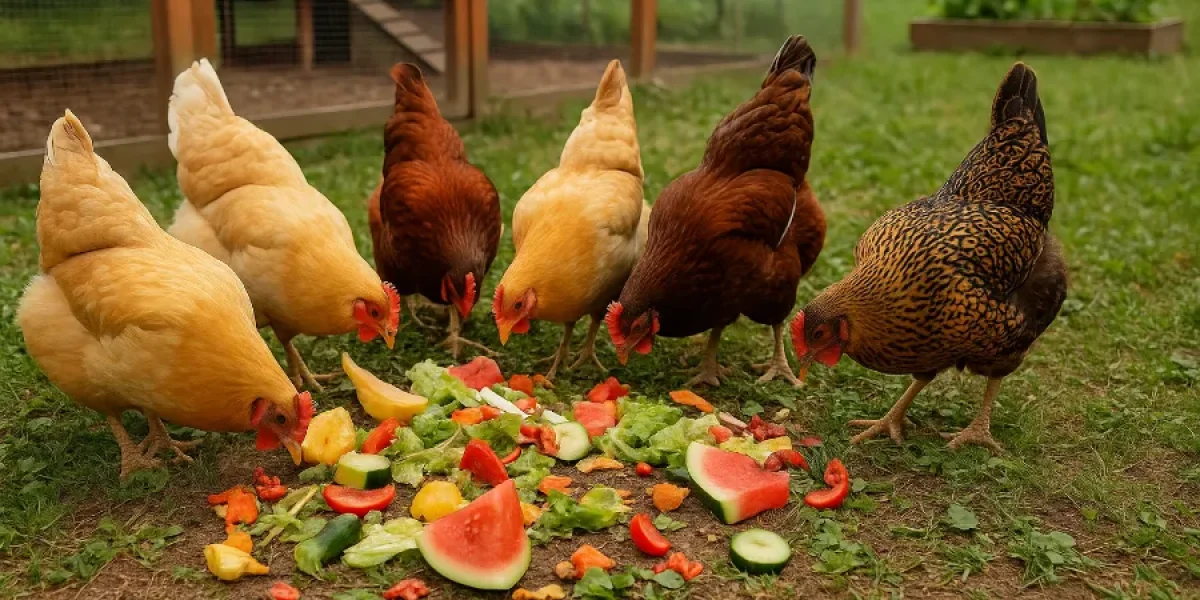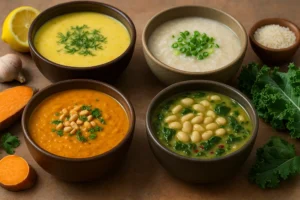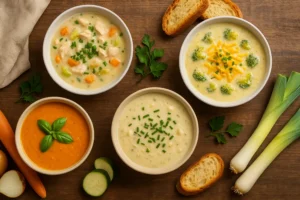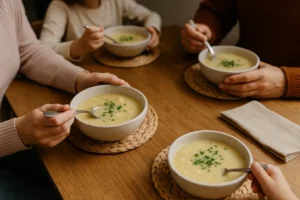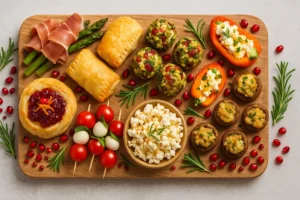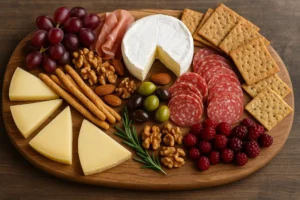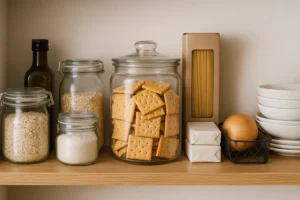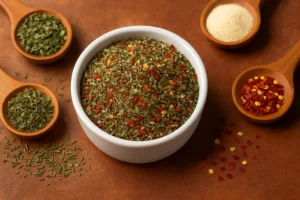call it a day. Instead, I discovered how rewarding it can be to transform everyday leftovers into part of a vibrant, thriving flock. This post is all about safe kitchen scraps you can feed backyard chickens — how to do it well, how to do it affordably, and how to make it part of a modern, sustainable feeding system inspired by home kitchens and restaurants.
Chicken Feed – The Foundation of a Healthy Flock
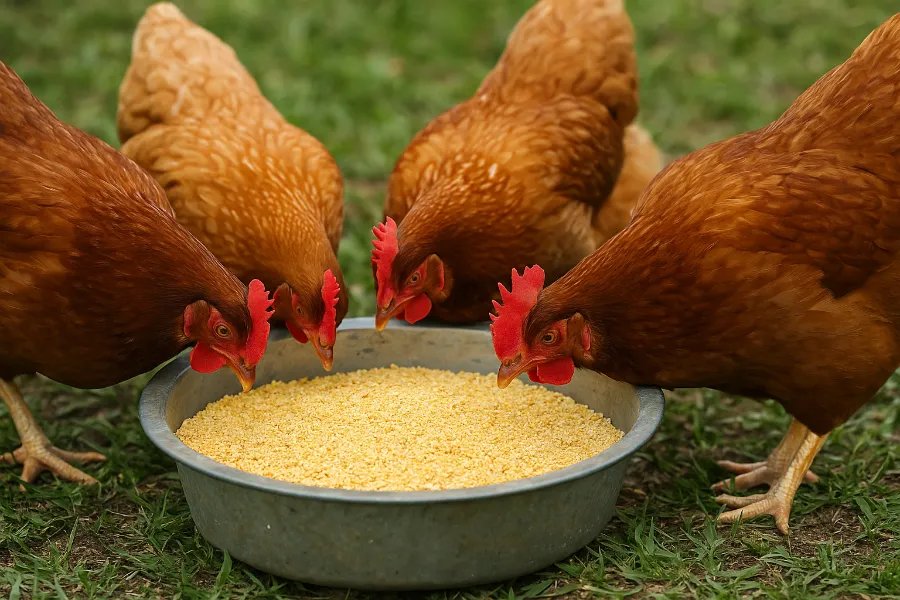
Before going full scrap mode, it’s important to remember that your regular layer feed is still the foundation of your chickens’ diet. A high-quality feed ensures they get the vitamins, minerals, and protein they need for strong shells and steady laying. Kitchen scraps should supplement—not replace—this base. Think of scraps as the side dish to the main meal of chicken feed.
In my routine, I let the flock eat their regular feed in the morning. Later in the day, I offer kitchen scraps as a treat. That keeps their nutrition balanced and prevents them from filling up on leftovers alone.
Chicken Treats – Making Feeding Fun and Varied
Once the basics are covered, kitchen scraps become fun. “Chicken treats” doesn’t mean junk food—it means small, safe extras your birds will love. I’ve found that treats boost their curiosity, reduce boredom, and even improve social behavior in the flock.
Some of my flock’s favorite treats include:
- Watermelon rinds and chopped melon during hot summer days
- Apple cores without seeds and banana peels chopped into bits
- Stale whole-grain bread, torn into pieces
- Cooked oatmeal mixed with leftover vegetables for a warm mash
When I feed these, the hens gather eagerly. It’s satisfying to watch them recycle what might have gone into the trash.
Feeding Chickens – A Modern Approach from Kitchen to Coop
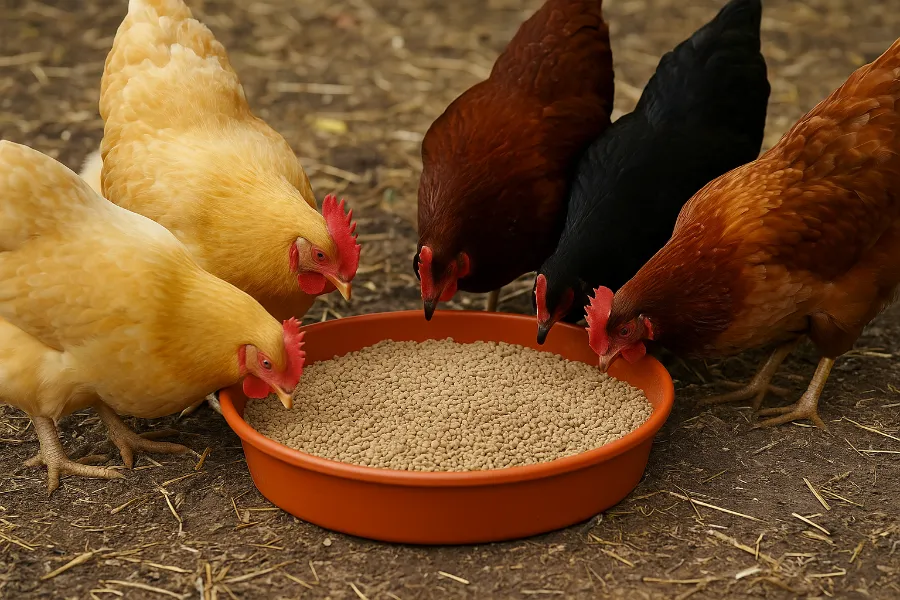
Feeding chickens used to mean tossing out a bucket of grain and hoping for the best. But today, I see feeding chickens as a thoughtful cycle that connects kitchen and coop.
Here’s how I do it:
- I keep a small container in the kitchen labeled “coop scraps.”
- Into it go clean, unseasoned leftovers like chopped vegetable ends, fruit cores, and bits of cooked rice or oats.
- At the end of the day, I bring it to the run and scatter the scraps for the hens to forage.
- I make sure it’s early enough that pests won’t come around after dark.
This routine reduces waste and keeps my flock active. Many small cafés and restaurants use a similar system, donating trimmings like veggie ends or spent grains to nearby farms. It’s a modern way to feed with purpose.
Chicken Diet – What Kitchen Scraps Fit the Bill
When it comes to kitchen scraps for chickens, “safe” and “balanced” are the key ideas. Below are the best options, ranging from everyday budget scraps to the occasional premium treat.
Budget-friendly scraps (everyday kitchen)
- Carrot peelings and tops
- Leafy greens such as kale, spinach, and lettuce
- Cooked rice or oatmeal
- Stale whole-grain bread
- Apple cores and melon rinds
These cost nothing and keep food waste low.
Premium or restaurant-style scraps (when available)
- Unsold whole-grain loaves or trimmings from bakeries
- Clean vegetable ends or herb stems from kitchen prep
- Spent grains from breweries (high in protein)
- Plain cooked lean meat scraps from catering or meal prep
When I have these on hand, I treat my hens to a “feast day.” It keeps things interesting and adds variety to their diet.
Chicken Nutrition – What to Watch For
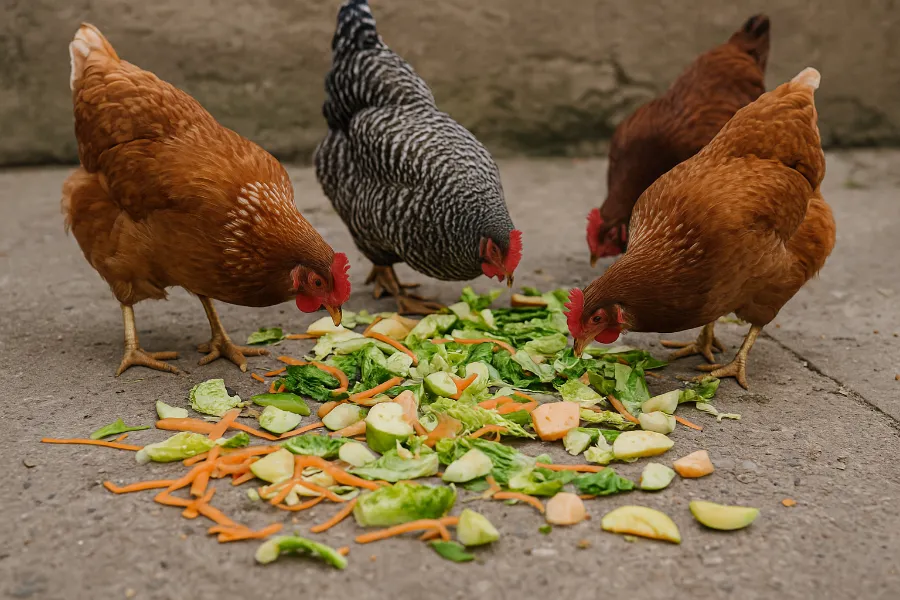
Because kitchen scraps are supplements, it’s worth paying attention to a few nutritional guidelines:
- Protein: During molting or cold months, add cooked eggs, plain meat, or yogurt for an extra boost.
- Calcium: Crushed, baked eggshells or oyster shell help maintain hard eggshells.
- Balance: Keep scraps under 15% of the total diet. Too much filler can dilute nutrition.
- Variety: Rotate fruits, veggies, grains, and proteins.
- Freshness: Never feed moldy, sour, or heavily seasoned food. Avoid avocado and large amounts of onion or garlic.
Kitchen Compost Bin – Making Scraps Work for the Coop and the Garden
I keep two bins in my kitchen: one for the coop and one for the compost. The “coop” bin gets safe, unseasoned scraps for feeding. The compost bin takes the rest—coffee grounds, citrus peels, avocado skins, or anything spoiled.
At the end of the day, I feed what’s safe and transfer the rest into the garden compost pile. When the hens leave uneaten bits behind, I toss those into the compost too. Mixed with chicken manure and bedding, it turns into nutrient-rich soil for my vegetables. This small system keeps my household nearly zero-waste.
Natural Chicken Diet – Aligning with Their Instincts
Chickens are natural foragers. They love to scratch and search for food. Feeding them scraps that encourage those instincts—like scattering chopped greens or leaving a melon half in the run—keeps them mentally active and physically healthy.
When deciding what to give, I ask: “Would this exist in a natural environment?” If the answer is yes, I feed it in moderation. If not—if it’s greasy, sugary, or salty—it stays in the compost.
Sustainable Homesteading – Waste to Wellness
One of the most rewarding parts of keeping chickens is how they fit into a larger homestead ecosystem. Feeding scraps ties directly into sustainable homesteading by turning waste into productivity.
Here’s how the cycle works on my small property:
- Kitchen scraps go to the coop.
- Chickens eat them and produce manure.
- The manure and leftovers go to the compost.
- The compost enriches the garden.
- The garden grows more vegetables that end up back in the kitchen.
It’s a closed loop. Nothing wasted. Everything reused.
Composting Chicken Manure – Turning the Coop into Fertility
After feeding scraps, the coop floor fills with manure and bedding. Instead of throwing it away, I compost it. Every few weeks, I clean the coop, pile the manure and shavings, and add a mix of garden clippings or uneaten scraps.
Over a couple of months, it breaks down into rich, dark compost that goes into my raised beds and fruit trees. The quality difference is incredible, and it feels good knowing that my hens’ waste becomes part of the garden’s fertility cycle.
My Scrap Feeding Routine
Here’s how I manage my week with kitchen scraps:
- Monday–Wednesday: Everyday scraps like greens, peels, and fruit bits.
- Thursday: Special treat day—fresh melon, yogurt, or bakery trimmings.
- Friday: Protein focus—cooked eggs or plain meat.
- Weekend: Compost clear-out—scraps from the garden and fridge clean-ups.
This rhythm keeps things balanced, and I always monitor egg quality. If shells soften or hens seem sluggish, I cut back on scraps and add more feed.
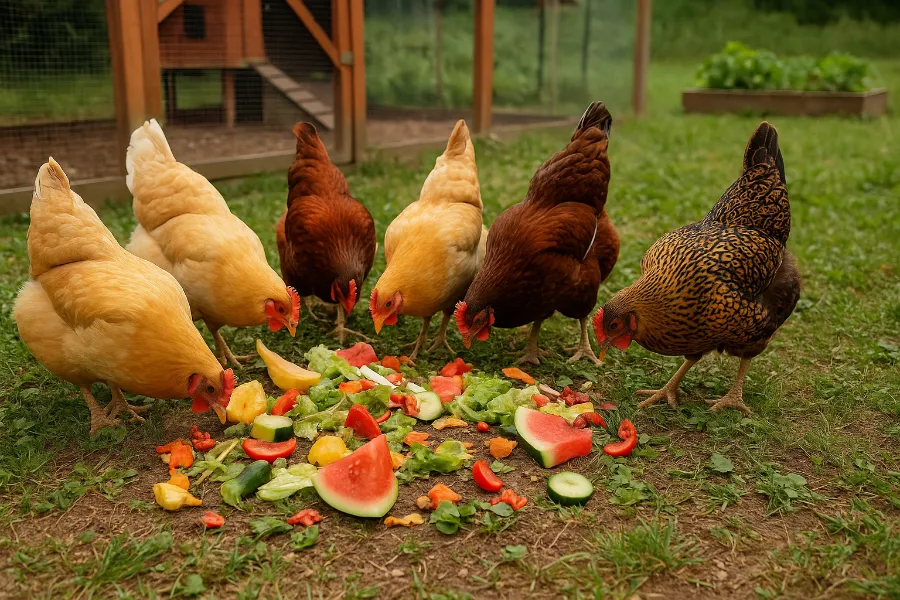
What to Avoid – Common Mistakes
Even though chickens love variety, some foods are off-limits. Avoid:
- Heavily seasoned or greasy leftovers
- Moldy or spoiled food
- Desserts or sugary snacks
- Avocado, raw potato peels, citrus rinds in large amounts
- Leaving scraps out overnight (attracts pests)
When in doubt, skip it. Freshness and simplicity are always safest.
Final Thoughts – Feeding with Purpose
Feeding kitchen scraps for chickens has become one of my favorite parts of keeping a flock. It connects my kitchen, my hens, and my garden in a sustainable cycle. Every banana peel or carrot top that avoids the trash contributes to something bigger—better eggs, richer soil, and less waste overall.
It’s not just feeding; it’s stewardship. It’s taking responsibility for what comes out of your kitchen and giving it new life through your chickens. So next time you slice up a melon or peel a carrot, think of your flock—they’ll be waiting.
FAQs
Fruits, vegetables, whole grains, and cooked eggs are great options. Avoid anything spoiled, salty, or seasoned.
Yes, as long as they’re plain and unseasoned. Skip anything fried, greasy, or containing garlic, onion, or salt.
Keep scraps to around 10–15% of their total diet. The rest should come from balanced chicken feed.
You can, if the food is clean and simple—like veggie ends or cooked rice. Never feed seasoned or processed foods.
Absolutely. Rinse, bake, and crush eggshells before feeding—they’re a great source of calcium for strong shells.
Avoid avocado, raw potato peels, citrus rinds, chocolate, and moldy food. These can cause illness or toxicity.
They reduce food waste, cut feed costs, and enrich compost when mixed with chicken manure—closing the kitchen-to-coop loop.

